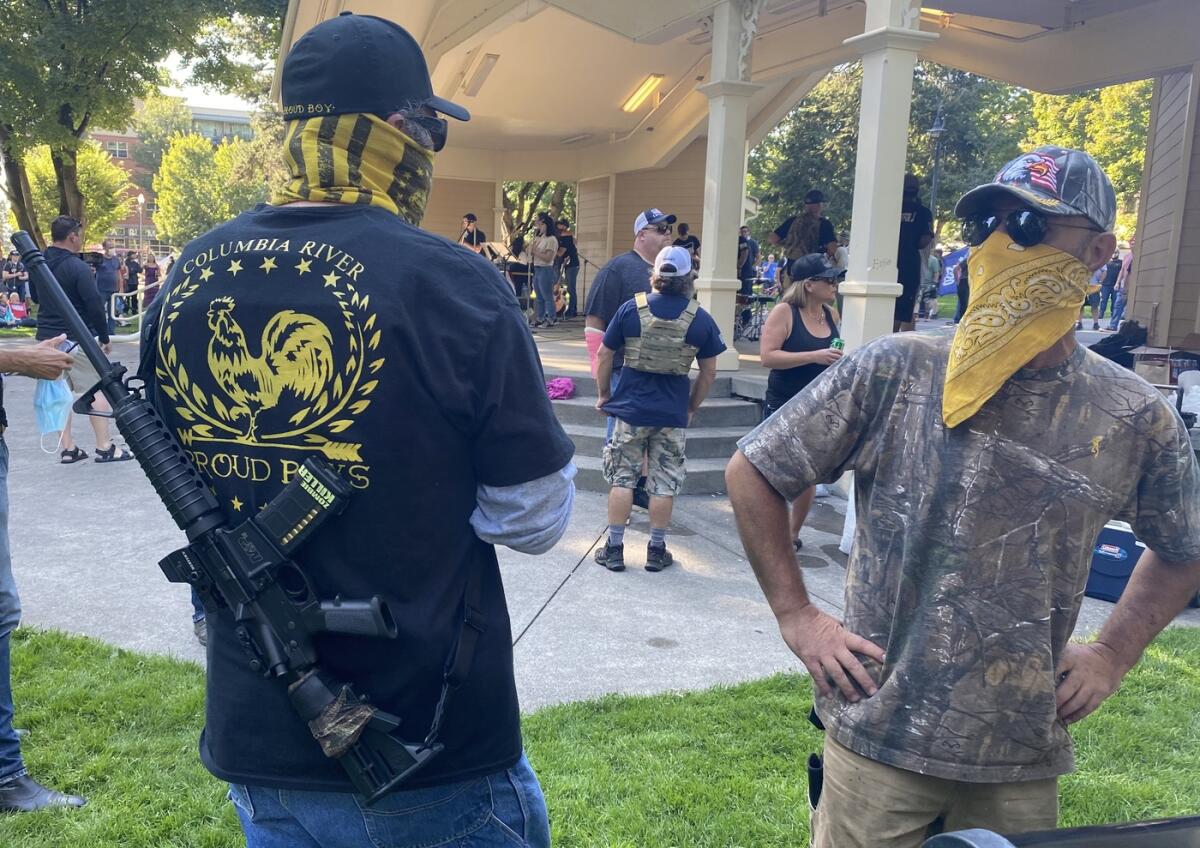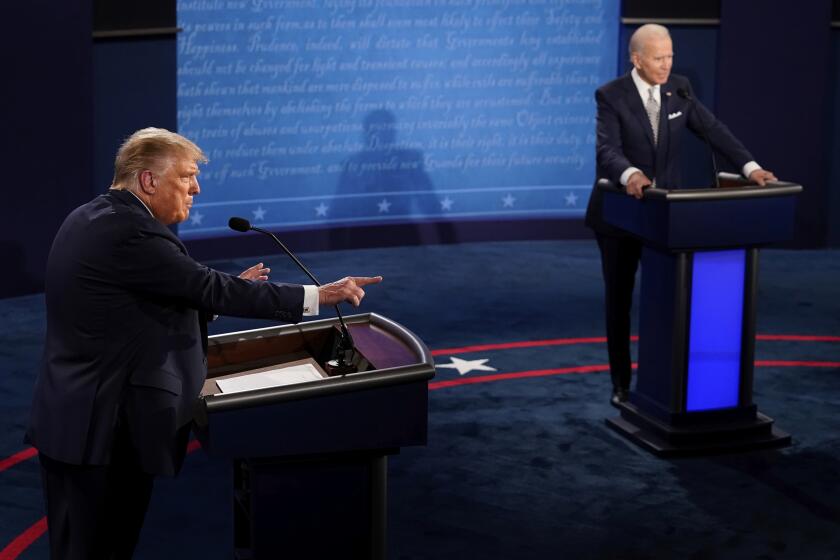Q&A: What is President Trump’s relationship with far-right and white supremacist groups?

- Share via
On Tuesday night, President Trump once again emboldened the violent far-right when he deflected a debate moderator’s request to tell those groups to stand down, instead responding that one such organization, the Proud Boys, should “stand back and stand by,” adding, “Somebody has got to do something about antifa and the left.”
Here’s what you need to know about the far-right movement in the U.S. and why the president’s remarks were significant.
What does ‘far right’ mean?
There is no single definition of what it means to be “far right,” which is a broad term applied to a fragmented series of groups and ideologies that have operated along the fringes of U.S. politics, some for well over a century. Such groups embrace ideals of white racial purity, ultranationalism, “Western civilization” or male dominance. They have often expressed hostility to Black people, immigrants, members of certain religious groups (typically Jews, Muslims and Catholics), left-wing organizations, feminists, the federal government and even liberal democracy itself.
Far-right groups are also often labeled as racists, white supremacists, white nationalists, fascists, “alt-right,” neo-Nazis, neo-Confederates, chauvinists and militias, with the distinction frequently depending on their history or ideology. Historically, America’s best-known right-wing extremist organization is the Ku Klux Klan, which was violently dedicated to preserving white power after the Confederacy’s defeat in the Civil War brought new rights to formerly enslaved Black Americans.
The Klan’s power has waned, but such groups continue to appear in the public sphere. Many Americans will be most familiar with their gathering at the 2017 “Unite the Right” rally in Charlottesville, Va., where far-right groups clashed with anti-racist protesters, killing one woman.
Republicans cringe at Trump’s refusal to clearly denounce white supremacists as Joe Biden begins a campaign swing through two key states.
Who are the Proud Boys?
The Anti-Defamation League, which monitors extremists, describes the Proud Boys as “violent, nationalistic, Islamophobic, transphobic and misogynistic,” but says “its members represent a range of ethnic backgrounds, and its leaders vehemently protest any allegations of racism.”
Its membership is estimated to be in the hundreds, organized into local chapters that have attended public rallies and protests and sometimes violently confronted left-wing protesters. Its founder, Gavin McInnes, describes the group as a “pro-Western fraternity,” but the Anti-Defamation League says it has “many of the hallmarks of a gang, and its members have taken part in multiple acts of brutal violence and intimidation.”
On Wednesday, media outlets in Portland, Ore., reported that one Proud Boy member had been arrested on suspicion of assault and pointing a gun at anti-fascist protesters at an Aug. 22 confrontation in the city.
What is Trump’s relationship to the far right?
Trump’s groundbreaking 2016 presidential campaign energized far-right groups as he made harsh attacks on immigrants, Muslims, liberals and the idea of America as a collaborative participant in international diplomacy and trade. He embraced what are sometimes called “white grievance” politics, attracting large numbers of white voters, most frequently men, who believed that they themselves had been the victims of racial discrimination.
After winning, Trump populated his White House with hard-line conservatives such as Stephen K. Bannon, whose website Breitbart had been a key platform for elevating the so-called “alt-right,” which turned out to just be another name for fascism.
This drew praise from the far right, which felt that in Trump it now had a vessel to inject its own extremist politics into the mainstream after decades of marginalization, humiliation and defeat.
As The Times reported in 2016, David Duke, a former Klan grand wizard, declared that “the fact that Donald Trump’s doing so well, it proves that I’m winning.” Richard Spencer, president of the National Policy Institute, who called for a separate white nation, said, “Before Trump, our identity ideas, national ideas, they had no place to go.” Andrew Anglin, operator of the neo-Nazi website the Daily Stormer, said, “Virtually every alt-right Nazi I know is volunteering for the Trump campaign.”
How has Trump talked about the far right in the past?
It’s typical for politicians to publicly distance themselves from their most extreme supporters, usually to avoid alienating moderates or energizing opponents. But Trump, who has sometimes retweeted Twitter accounts associated with white nationalists, has often stumbled, prevaricated, pleaded ignorance or shifted blame to the left when confronted about his support from the far right.
In 2016, after retweeting a quote by Benito Mussolini, the Italian fascist leader who was allied with Adolf Hitler, Trump said, “Look, Mussolini was Mussolini … and I know who said it,” calling it “a very good quote, an interesting quote.”
Asked to disavow Duke and the KKK, Trump evaded, saying, “I don’t know anything about David Duke. I don’t know anything about what you’re even talking about with white supremacy or white supremacists. So, I don’t know.”
After the deadly 2017 Charlottesville rally, Trump told reporters: “I’ve condemned neo-Nazis; I’ve condemned many different groups,” but said he believed that not all of the right-wing participants were neo-Nazis, and that “you also had people that were very fine people on both sides.”
That comment caused an uproar among Trump’s critics, who took the remark as Trump calling neo-Nazis “very fine people” and who denounced his unwillingness to take a hard stand against racists while the nation was rattled by its largest fascist gathering in years.
What Trump said at the debate
At Tuesday night’s debate, moderator Chris Wallace gave Trump yet another chance to denounce far-right radicals, and the president once again created an uproar with his unwillingness to denounce extremist supporters.
“Are you willing tonight to condemn white supremacists and militia groups and to say that they need to stand down and not add to the violence in a number of these cities ... ?” Wallace asked.
“Sure, I’m willing to do that. I would say, I would say, almost everything I see is from the left wing, not from the right wing,” Trump said. “I’m willing to do anything. I want to see peace.”
“Then do it, sir,” Wallace said.
“Say it. Do it. Say it,” Democratic nominee Joe Biden said.
“You want to call ’em — what do you want to call ’em? Give me a name, give me a name,” Trump said. “Who would you like me to condemn?”
Wallace and Biden, talking over each other, suggested “white supremacists” and the right-wing group the Proud Boys.
“Proud Boys, stand back and stand by — but I’ll tell you what, I’ll tell you what, somebody’s got to do something about antifa and the left,” Trump said.
Many listeners, including members of the Proud Boys, saw Trump’s response as a sign of support, the opposite of a denunciation.
Facing widespread criticism afterward, Trump attempted Wednesday to walk back his remark, saying, “I don’t know who Proud Boys are, but whoever they are, they have to stand down, let enforcement do their work.” But he reiterated, “now, antifa is a real problem, because the problem is on the left.”
Pressed again by a reporter to denounce white supremacists, Trump responded, “I’ve always denounced any form of any of that.”
More to Read
Get the L.A. Times Politics newsletter
Deeply reported insights into legislation, politics and policy from Sacramento, Washington and beyond. In your inbox three times per week.
You may occasionally receive promotional content from the Los Angeles Times.












